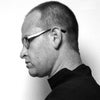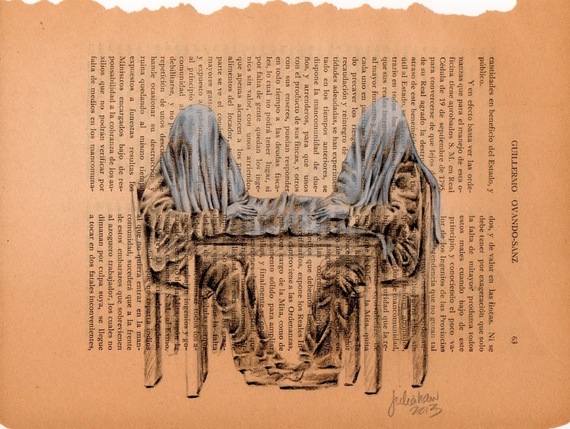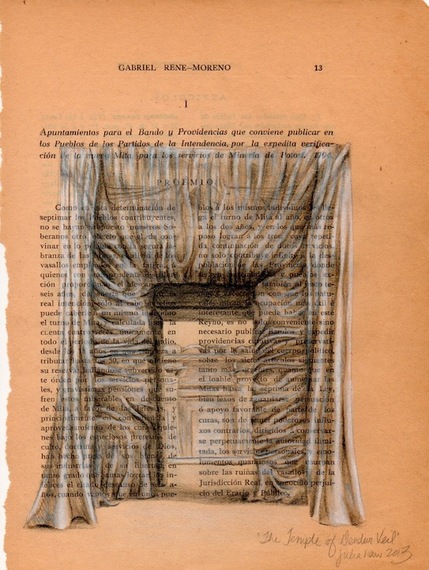One of the most disturbing images in the Harry Potter books is also one of its least violent. It appears in volume five, when Harry and company are exploring the Department of Mysteries.
...there was a raised stone dais in the center of the lowered floor, and upon this dais stood a stone archway that looked so ancient, cracked and crumbling that Harry was amazed the thing was still standing. Unsupported by any surrounding wall, the archway was hung with a tattered black curtain or veil which, despite the complete stillness of the cold surrounding air, was fluttering very slightly as though it had just been touched.
...He had the strangest feeling that there was someone standing right behind the veil on the other side of the archway. Gripping his wand very tightly, he edged around the dais, but there was nobody there. All that could be seen was the other side of the tattered black veil.
"Let's go," called Hermione from halfway up the stone steps. "This isn't right, Harry, come on, let's go..."
She sounded scared.
- J. K. Rowling, Harry Potter and the Order of the Phoenix, pp. 773-4
There is a terrible premonition to this veiled archway, and indeed, a major character, falling through it later, vanishes -- dies.
The veil as a general proposition has a hideous and deathly quality. It imperfectly defines the form of an object while concealing its literal appearance. This allows for the clandestine presence of rot and defects, or the introduction of threatening objects altogether alien from their stated forms. The movement of the lightweight veil admits of the chicanery of ghosts, the manufacture of false images and illusory or misstated motions. The veil seems to present the appearance of a thing, and yet it hides it. The veil is aligned with death, but it is more frightening than death alone. Death is natural, but the veil is unnatural. It is spooky.
J. K. Rowling is far from the only artist to recognize the frightful nature of the veil. As a whispering companion of death, it drapes any number of graveyard urns and sculpted mourners. David Lynch invoked it with the strange shadows on the draperies of the Red Room in Twin Peaks. The veil's concealment of rot is observed in Kubrick's The Shining, in which the veil is drawn back to reveal a beautiful woman -- who is then revealed to be a rotting corpse, paradoxically still hidden behind the original veil. The veil in question is the classic horror movie veil: a shower curtain.
Perhaps the veil is so frightening in part because it allows the unknown to coexist in space with us. A window separates and reveals, and a wall provides protection at the price of ignorance. But a veil enforces ignorance without separation. It brings the threat close to hand. It makes clothing a zero sum game: the unknown goes draped in the veil, because we go naked and defenseless to meet it.
I believe Chicago artist Julia Haw has found her way to some similar understanding of the veil with the work in her solo show "The Western Veil." She recounts the New York inspiration for her series of drawings and paintings of veiled people and things.
"Walking down 17th street home each night I'd pass by a little park. This homeless person was there almost every night and would sleep with a long towel draped over his/her head."
This harbinger led to drawings of draped things:
The drapery negates the functionality of the draped object. Can the meal be eaten any longer? Is it, in fact, a meal? This opposition of the veil to the stated utility of the object becomes clearer in The Unusable Hand:
And gradually, the veil overtakes and transforms every scene and instance to which Haw turns her eye:
What conversation is possible in the face of the interruption of the veil? And, if a conversation is indeed possible, in what awful language must it be hissed?
It's strange to recognize that one is looking at "horror art" -- it is not a large genre, and as is the case with horror movies, it is dominated by mere fetishism. There is only a narrow sliver of horror art which, rather than ginning up some nastiness, identifies and excavates a horrific aspect of the actual world. Such work, visual art and film alike, is rooted in genre but transcends it. Haw is making this kind of transcendental horror art.
She pictures a landscape utterly given over to the veil, a terrifying sub-world in which everything is familiar and yet nothing is nameable -- everything on the verge of its blithely assumed role, and yet each particular thing disrupted and useless. Her world is quiet, but menacing. It is menacing in itself, and menacing also in the possibility that this is reality, if only we could see it clearly. It convincingly suggests that the seeming clarity of the everyday is the illusion, and if we could reach true sight, we would see that everything goes shrouded.
Haw, like Rowling, ultimately came to see the point of entry into her deathly universe as a kind of archway or gate. Visiting the famous Temple of Dendur at the Metropolitan Museum of Art, she found her key image. It stood transformed before her, a real thing overlaid in her mind's eye with the wicked, wicked veil:
"The Western Veil" by Julia Haw
(actual exhibit addresses wider themes, and includes paintings)
Exhibiting via the Illinois State Museum as part of Focus 4: Four Solo Exhibitions
April 14th-Aug 15th 2014 Thompson Center, Chicago, IL
Opening Reception April 25th 5-8 p.m.




